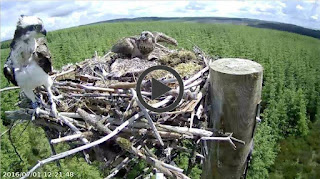 UV started his second
annual migration on the morning of the 10th of September
2016. It would be pleasant to recount that his departure was
accompanied by cheering crowds of well-wishers lining the route –
perhaps even that the traditional northern colliery band played a
stirring march, while fluttered cambric handkerchiefs and a silent
tear from the more demonstrative hearts sped him on his way.
UV started his second
annual migration on the morning of the 10th of September
2016. It would be pleasant to recount that his departure was
accompanied by cheering crowds of well-wishers lining the route –
perhaps even that the traditional northern colliery band played a
stirring march, while fluttered cambric handkerchiefs and a silent
tear from the more demonstrative hearts sped him on his way.Of course, it wasn't like that at all.
Be they ever-so-famous in Internet Land, individual ospreys perform this last act of the summer season unobserved, for the most part. It marks the point where they transition back to the solitary existence of winter, and only those who are directly observed by scope or camera - or have a tracking unit – will have the actual start of their migration recorded as such.
Perhaps it is as well that the trombones didn't turn out, because UV's commencement was an inauspicious one.
For days, a succession of southerly and south-westerly gales had lashed across the west of Great Britain. After the misery of a damp summer almost devoid of sun, it was looking like one of the most turbulent Septembers on record. But by the morning of the 10th, the wind seemed to have changed direction for the better and many birds began to move southwards towards the coast. The adventure was under way. UV was off to Africa at last.
He got as far as Gloucestershire.
Another series of weather fronts raced in, bringing poor visibility and yet more adverse winds. From Kent to Cornwall, thousands of migrant birds were already waiting for a chance to cross into France. An inexperienced juvenile osprey might have joined their ranks but UV is no longer a raw recruit. He paused his migration at the River Severn and went fishing instead. The weather finally relented on the morning of the 16th, enabling our boy to make his move.
And move, he certainly did.
In the following nine hours he covered 373 km. Giving Weymouth no more than a passing glance (as you would) he launched himself out over the Channel. Off the island of Alderney, UV's (wind assisted) flying speeds were some of the highest ever recorded by us for a migrating osprey, peaking at 118 kph.
The accompanying maps show what happened next: UV 'cut the corner' through Brittany and by afternoon the next day was out over the sea off Saint-Nazaire.
Adult ospreys have the same journey to undertake as juveniles of their kind, but they have one major advantage: they know where they are going and - perhaps even more importantly - they know how far they have to go. A migrating adult has the option of breaking the overall route into manageable sections, according to the prevailing conditions and how much each bird has in the way of energy reserves. This strategy is known as “staged migration”.
UV was aiming to stage at his favourite group of irrigation reservoirs – the barragens of south-west Portugal, and he wasted little time in reaching them by the 21st.
He may have got an unpleasant surprise there. Diligent research by Joanna Dailey found that serious drought conditions have been affecting this region, and we believe that many of the dams had unusually low water levels this year. This may have made fishing more difficult for UV and we noted several unusual local movements at high altitudes, where he seemed to be surveying the area and – perhaps – keeping an eye on distant weather conditions with a view to moving on. (We have withheld exact details of UV's foraging locations in Portugal for protection reasons.)
Whatever the fishing situation might have been, it persuaded UV that two weeks in Portugal was enough. On 4th October he was off again, following closely the same route that he had taken in 2014, and this time his navigation was precise. After a 980+ km over-sea flight, his landfall in Morocco was only 14 km away from the previous one.
On that occasion, UV had staged at the remote Gulf of Cintra in Western Sahara. So... would it be Cintra again, this year? It would not. That weather-enforced break on the River Severn had shifted UV's “refuelling” schedule just enough. There were no more helpful tailwinds in the desert but, employing the energy saving 'soar-and-glide' technique on plentiful thermals, UV easily covered the remaining distance to northern Senegal.
 |
| UV Migration Map 2016 (2014 route in green) |
Because that's what they do.
All of this information comes from lines and dots and plots on a computer screen, the shadow-tracks of the processed data. But Blue UV is no shadow. For all our marvellous technology, we never forget that he is a living creature. As we track their movements, so UV and his kin track our understanding, waiting to see how we apply it to the benefit of all their species.
And that's one hell of a responsibility.
-Wlw
Kielder osprey blog: https://kielderospreys.wordpress.com/















